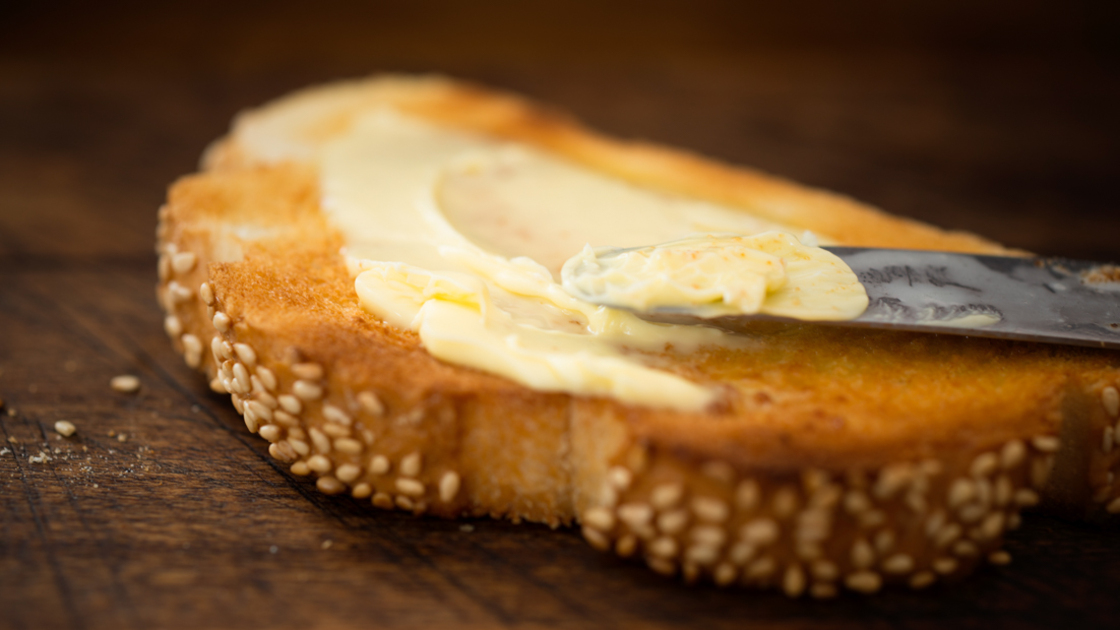“If I eat fat, I’ll get fat.” Is that true? What is fat? How much and what types should you consume? Are low-fat or fat-free foods better for you than toast with butter or homemade salad dressings?
Fat is a macronutrient that provides energy, helps assimilate certain vitamins and minerals, supports brain health and function, stabilizes metabolism, protects and cushions the organs, and provides the building blocks for essential structures in the body, including hormones. Without fat, we couldn’t survive.
Not all fats are created equal, however. Some are better than others, and some fats are harmful to the body. So, which ones should you eat and which ones should you avoid? The list below should help you decide which fats to consume.
Saturated Fats
Examples: Butter, cheese, milk, cream, coconut oil, egg yolks.
What can I do with them? Use them for cooking foods at higher temperatures, like frying and sautéing. Add butter to your toast, put a dollop on top of steamed vegetables, or grease your pans with it before baking. Use coconut oil in smoothies, for stir-frys, and for popping popcorn. For a fun new creamer, whip your coffee with one tablespoon each of grass-fed butter and coconut oil, and then add heavy cream with a squirt of vanilla or almond extract.
How do they work? Saturated fats are the most stable when exposed to heat, light or oxygen; that means they don’t go rancid easily. Rancid fats contain free radicals, which encourage the aging of cells as well as mutate dna and cause diseases like cancer.
Contrary to popular belief, saturated fats promote good health. Although demonized by the mainstream media for causing illnesses such as heart disease and cancer, they actually play a vital role in the health of the body. They form at least half the body’s cell membranes, promote brain development and health, strengthen the skeletal and immune systems, and give your heart a good source of energy. The Bible encourages consumption of saturated fats (e.g. Isaiah 7:22; Genesis 18:8; 2 Samuel 17:29). God even praises the use of butter: “Butter and honey shall he eat, that he may know to refuse the evil, and choose the good” (Isaiah 7:15).
Unsaturated Fats (Monounsaturated)
Examples: Olive oil (and similar fats that are liquid at room temperature).
What can I do with them? Discover the world of delicious homemade salad dressings! You can make your own customized raspberry balsamic vinaigrette, spicy honey-mustard, French and so many more. You can even make your own mayo, and from that, create your own homemade ranch dressing.
How do they work?
Monounsaturated oils are more stable than polyunsaturated oils because they have fewer molecular carbon bonds. So there are fewer bonds where oxidation can occur. They won’t go rancid quite as easily nor cause free radicals to damage the body.
These fats are less stable than saturated fats in general, so take care in what type of oils you buy. Look for extra virgin, first cold-pressed olive oil, preferably with a “pressed on” or “use by” date. In fact, a good test for olive oil fraud is to place your jar of olive oil in the refrigerator for a couple of days. It should become solid. If it remains a free-flowing liquid, it has had cheaper polyunsaturated oils added by the manufacturers. Also don’t cook at high temperatures with olive oil. It’s best when used on medium to low heat on your stove.
Unsaturated Fats (Bad Polyunsaturated)
Examples: Canola, sunflower, corn, soybean, cottonseed, safflower, grape seed and most commercial vegetable oils.
What can I do with them? Hopefully as little as possible! These are perhaps the most common and readily available fats. It takes diligence to avoid these pervasive fats, which include commercial salad dressings, snack foods, coffee creamers and most other prepared foods.
How do they work? Polyunsaturated oils are the least stable of all oils. Most processing techniques do not protect them, so their bonds break down and they’re rancid straight off the grocery store shelves. The unsavory taste and smell are masked by added flavorings and perfumes.
Unsaturated Fats (Good Polyunsaturated)
Examples: Fish, nuts, flaxseeds
What can I do with them? Eat more fish when you have the chance. Enjoy a homemade trail mix, or grind your own flaxseed for oatmeal and smoothies. Instead of reaching for chips, grab some nuts. (Try a recipe for crispy nuts.) Some supplement their diet with cod liver oil and flaxseed oil.
How do they work? Good polyunsaturated fats are still volatile; to be beneficial they need to be unprocessed, unexposed to light or heat. In their natural state, these fats are wonderful fatty acids that contribute to brain health and memory; help to prevent diseases such as Osteoporosis, Crohn’s disease, adhd, autoimmune disorders and arthritis; and improve heart health and levels of cholesterol.
Handy Tips
Avoid trans-fats (hydrogenated or partially hydrogenated oils). These are artificially saturated oils with changed chemical structure in a form the body can’t use. One example is margarine. Chips, crackers, baked sweets and treats are loaded with them. Even if a commercial food advertises “no trans-fats,” it likely still contains processed polyunsaturated fats.
Use cold-pressed, refrigerated vegetable oils that come in dark bottles (found mainly at health food stores). Enjoy butter, cheese, cream, eggs (yolk included!) and coconut oil, as well as avocados, nuts and seeds. The rule of thumb is: The more natural and closer to what God created, the better and healthier the fat.
Remember, all forward motion counts. Pick one tip or suggestion above to implement today. As that becomes part of your routine, perhaps choose another suggestion to implement. Every step made toward healthier eating leads to a healthier you!
